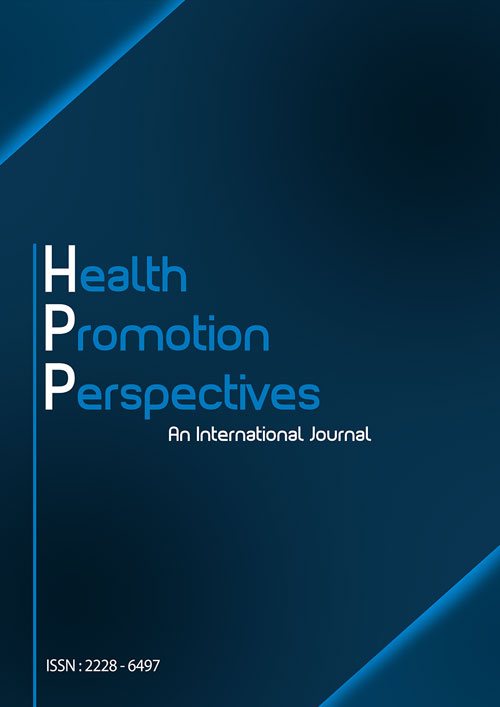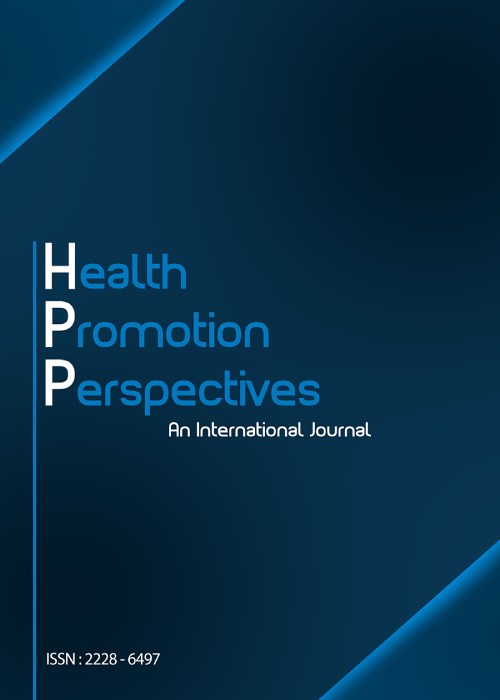فهرست مطالب

Health Promotion Perspectives
Volume:6 Issue: 2, Jun 2016
- تاریخ انتشار: 1395/03/25
- تعداد عناوین: 9
-
-
Pages 55-57BackgroundParenting magazines serve as a platform for advertisers to target children and their caregivers. The purpose of this study was to analyze and describe the number of pictures of sedentary and non-sedentary children pictured in the popular parenting magazine, Parents.MethodsOur sample consisted of 72 issues from Parents magazine from January 2010 to December 2015. The sampling frame consisted of all printed issues over this time period. All pictures of children, whether they were in advertisements or models appearing throughout the magazine were included. There were a total of 11 018 children images reviewed.ResultsThe overwhelming majority included sedentary children (n = 9734, 88.3%), while the minority showed children engaged in some kind of activity (n = 1284, 11.7%).ConclusionParents are encouraged to discuss with their pediatricians which activities are most beneficial for their childrens health.Keywords: Sedentary, Physical inactivity, Child health, Media
-
Pages 58-65BackgroundMost college students do not adequately participate in enough physical activity(PA) to attain health benefits. A theory-based approach is critical in developing effective interventions to promote PA. The purpose of this study was to examine the utility of the newly proposed multi-theory model (MTM) of health behavior change in predicting initiation and sustenance of PA among college students.MethodsUsing a cross-sectional design, a valid and reliable survey was administered in October 2015 electronically to students enrolled at a large Southern US University. The internal consistency Cronbach alphas of the sub-scales were acceptable (0.65-0.92). Only those who did not engage in more than 150 minutes of moderate to vigorous intensity aerobic PA during the past week were included in this study.ResultsOf the 495 respondents, 190 met the inclusion criteria of which 141 completed the survey. The majority of participants were females (72.3%) and Caucasians (70.9%). Findings of the confirmatory factor analysis (CFA) confirmed construct validity of sub-scales (initiation model: χ2 = 253.92 [df = 143], PConclusionBased on this studys findings, MTM appears to be a robust theoretical framework for predicting PA behavior change. Future research directions and development of suitable intervention strategies are discussed.Keywords: College students, Physical activity, Multi, theory model, Exercise, Needs assessment
-
Pages 66-70BackgroundThe purpose of this study was to examine the cumulative effects of psychological,socioeconomic, biological and behavioral parameters on mortality.MethodsA prospective design was employed. Data from the 2005-2006 National Health and Nutrition Examination Survey (NHANES) were used (analyzed in 2015); follow-up mortality status evaluated in 2011. Psychological function was assessed from the Patient Health Questionnaire-9 (PHQ-9) as a measure of depression. Socioeconomic risk was assessed from poverty level, education, minority status, and social living status. Biological parameters included cholesterol, weight status, diabetes, hypertension and systemic inflammation. Behavioral parameters assessed included physical activity (accelerometry), dietary behavior, smoking status (cotinine) and sleep. These 14 psycho-socioeconomic bio-behavioral (PSBB) parameters allowed for the calculation of an overall PSBB Index, ranging from 0-14.ResultsAmong the evaluated 2530 participants, 161 died over the unweighted median followup period of 70.0 months. After adjustment, for every 1 increase in the overall PSBB index score,participants had a 15% reduced risk of all-cause mortality (HR = 0.85; 95% CI: 0.76-0.96). After adjustment, the Behavioral Index (HR = 0.73; 95% CI: 0.60-0.88) and the Socioeconomic Index(HR = 0.82; 95% CI: 0.68-0.99) were significant, but the Psychological Index (HR = 0.67; 95%CI: 0.29-1.51) and the Biological Index (HR = 1.03; 95% CI: 0.89-1.18) were not.ConclusionThose with a worse PSBB score had an increased risk of all-cause mortality.Promotion of concurrent health behaviors may help to promote overall well-being and prolong survival.Keywords: Behavior, Biological, Epidemiology, Health, Psychology, Survival
-
Pages 71-79BackgroundModerate increase in physical activity (PA) may be helpful in preventing or postponing the complications of type 2 diabetes mellitus (T2DM). The aim of this study was to assess the psychometric properties of a health action process approach (HAPA)-based PA inventory among T2DM patients.MethodsIn 2015, this cross-sectional study was carried out on 203 participants recruited by convenience sampling in Isfahan, Iran. Content and face validity was confirmed by a panel of experts. The comments noted by 9 outpatients on the inventory were also investigated. Then,the items were administered to 203 T2DM patients. Construct validity was conducted using exploratory and structural equation modeling confirmatory factor analyses. Reliability was also assessed with Cronbach alpha and inter-class correlation coefficient (ICC).ResultsContent validity was acceptable (CVR = 0.62, CVI = 0.89). Exploratory factor analysis extracted seven factors (risk- perception, action self-efficacy, outcome expectancies, maintenance self-efficacy, action and coping planning, behavioral intention, and recovery self efficacy)explaining 82.23% of the variation. The HAPA had an acceptable fit to the observations(χ2 = 3.21, df = 3, P = 0.38; RMSEA = 0.06; AGFI = 0.90; PGFI = 0.12). The range of Cronbach alpha and ICC for the scales was about 0.63 to 0.97 and 0.862 to 0.988, respectively.ConclusionThe findings of the present study provided an initial support for the reliability and validity of the HAPA-based PA inventory among patients with T2DM.Keywords: Health behavior, Psychometric properties, Physical activity, Diabetes mellitus, Validation, Health action process approach
-
Pages 80-84BackgroundMagazines are a commonly used source for health and fitness information. Little is known about the nature and extent of weight loss strategies and products presented in mainstream womens health and fitness magazines.MethodsThis preliminary cross-sectional study evaluated the prevalence of articles and advertisements featuring weight loss content and products in mainstream US-based health and fitness magazines, as well as assessed weight loss themes presented. Thirty-one US health and fitness-focused magazine issues were coded. Prevalence of, product type, and themes related to weight loss in articles and advertisements were assessed.ResultsAmong the 31 issues of the five US-based womens magazines examined, we identified 39 articles (4.8% [95% CI = 3.3% to 5.5%] of 819 articles) related to weight loss with 14 identified weight loss topics. The most prevalent article topics covered were exercising/workouts(32.0% [95% CI = 28.8% to 33.6%]) followed by dieting (18.6% [95% CI = 15.9% to 19.9%]).The most common product advertised was weight loss pills (46.0% [95% CI = 42.6% to 47.7%]).Fat burners were also frequently advertised (14.9% [95% CI = 12.5% to 16.1%]) followed by hunger reduction strategies (10.3% [95% CI = 8.2% to 11.3%]) and fat blockers (6.9% [95% CI= 5.2% to 7.8%]).ConclusionArticles presented information about exercise and dieting whereas advertisements supported potentially harmful health beliefs and behaviors. As a well-utilized American media format, health and fitness-focused magazines have an opportunity to communicate frequent,accurate messaging about healthy weight reduction and limit advertisements that may include misleading claims.Keywords: Weight loss, Women's magazines, Advertisements, Articles
-
Pages 85-91BackgroundMammography as the most common secondary prevention method has known to be helpful in detecting breast cancer at the early stages. Low level of participation among women toward mammography uptake due to cultural beliefs is a great concern. This study aimed at exploring the perceptions of women about response costs of mammography adherence(MA) in Yazd, Iran.MethodsA qualitative study using semi-structured interviews was performed. Fourteen women,one oncology nurse, and a breast cancer survivor were purposefully interviewed. Interviews were transcribed verbatim and analyzed by directed content analysis method based on protection motivation theory (PMT).ResultsOne main theme was emerged from the analysis namely called response costs.Two main categories were also emerged from the data; (1) psychological barriers with six subcategories including embarrassment, worry about being diagnosed with cancer,preoccupation with underlying disease, misconception about mammography, need for an accompanying person, and internalizing the experiences of the others, and (2) maladaptive coping modes which encompassed three subcategories: religious faith, fatalism, andavoidance and denial.ConclusionUseful information was provided about the response costs of mammography utilization based on the perceptions of women. Cognitive barriers may be decreased by conducting modifications in womens awareness and attitude toward MA as well as changing the national health system infrastructures. Incorporating religious and cultural belief systems into MA educational programs through motivational messages is recommended.Keywords: Breast cancer prevention, Mammography adherence, Protection Motivation Theory, Response costs, Maladaptive, Coping modes, Directed content analysis
-
Pages 92-95BackgroundThe importance of the media in the coverage of Ebola virus disease (EVD) in Nigeria and its implications (negative or positive) amongst the populace cannot be overemphasized.This study was conducted to assess the role of media in the Ebola reportage and its implication in creating awareness and stopping the spread amongst the populace.MethodsThe nature and extent of media coverage about Ebola in four major national newspapers were examined. The four major national newspapers were The Sun, The Vanguard, The Nation and The Punch newspapers. The period of study ranged from 20 July (when the index case came to Nigeria) to 20 October 2014. Analysis of the newspaper article was according to content.ResultsA total of 1625 articles were published between July 2014 to October 2014 and these were divided into news (1127; 69.4%), features (267; 16.4%), opinion (76; 4.7%), editorials(149; 9.2%) and interviews (6; 0.4%). The most common topic was Ebola cases in Nigeria(17.5%) followed by discrimination due to Ebola (10.8%) and least of all the use of salt and or Kola for the cure of Ebola (5.2%).ConclusionAlthough the World Health Organization (WHO) declared Nigeria Ebola free on the 20th October 2014, continual reportage of the Ebola disease for effective awareness,prevention and control of the virus is recommended.Keywords: Ebola, Epidemic, Nigerian newspapers, Media
-
Pages 96-103BackgroundThe present study aimed to evaluate the operators mental workload (MW) of cement, city traffic control and power plant control centers using subjective and objective measures during system vital parameters monitoring.MethodsThis cross-sectional study was conducted from June 2014 to February 2015 at the cement, city traffic control and power plant control centers. Electrocardiography and electroencephalography data were recorded from forty males during performing their daily working in resting, low mental workload (LMW), high mental workload (HMW) and recovery conditions (each block 5 minutes). The NASA-Task Load Index (TLX) was used to evaluate the subjective workload of the operators.ResultsThe results showed that increasing MW had a significant effect on the operators subjective responses in two conditions ([1,53] = 216.303, PConclusionThe results suggested that when operators mental demands especially in traffic control and power plant tasks increased, their mental fatigue and stress level increased and their mental health deteriorated. Therefore, it may be necessary to implement an ergonomic program or administrative control to manage mental probably health in these control centers.Furthermore, by evaluating MW, the control center director can organize the human resources for each MW condition to sustain the appropriate performance as well as improve system functions.Keywords: Mental workload, ECG, EEG, NASA, TLX
-
Pages 104-110BackgroundSocial changes due to urbanism, acculturation, and fading of values have led to some challenges in family relationships, including domestic elder abuse. This study was conducted to determine elder abuse status in Yazd, Iran.MethodsThis cross-sectional study was conducted on 250 elderly people over 60 years in Yazd in 2014-2015. Clustered random sampling was used to recruit the participants from 10 clusters in Yazd (25 individuals from each cluster). The data were gathered by the 49-item,Iranian Domestic Elder Abuse Questionnaire which was filled out through private interviews with the participants.ResultsMean score of elder abuse was 11.84 (SD: 12.70) of total 100. Of the participants,79.6% (95% CI: 74.5-84.6) experienced at least one type of abuse. Emotional neglect was the most reported abuse and physical abuse was the least reported. Abuse score was associated with age, education level, living status, and insurance status of elders. Further, those who reported history of gastrointestinal problems, dyslipidemia, respiratory diseases, sleep disorders,audiovisual problems, joints pain, hypertension, dental/oral problems, cardiovascular disease,urinary incontinence and disability, reported a statistically significant higher abuse score.ConclusionDespite overall low rate of domestic elder abuse, its high prevalence indicates that some interventions are necessary to decrease domestic elder abuse. Emotional neglect of elders should be addressed more than other abuse types.Keywords: Elder Abuse, Prevalence, Yazd, Iran


